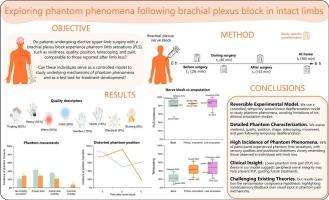Exploring phantom phenomena following brachial plexus block in intact limbs
IF 2.6
4区 医学
Q3 NEUROSCIENCES
引用次数: 0
Abstract
Background and objective
Phantom limb experiences, including phantom limb sensations (PLS) and phantom limb pain (PLP), are common after limb amputation or deafferentation, with PLP significantly impacting quality of life. However, the mechanisms underlying PLP remain unclear, complicating treatment development. Investigating phantom phenomena has been proposed to gain insights into the mechanisms behind the insurgence of PLS and PLP, potentially informing new therapeutic approaches. However, small, heterogeneous samples and a lack of objective pain metrics often limit research on individuals with limb loss.
Here, we investigate whether phantom experiences, similar to those reported after amputation, also occur in individuals with intact limbs following a brachial plexus nerve block, excluding the brain from afferent and efferent signals.
Methods
To investigate the phenomenon, we conducted a multifaceted phenomenological study involving 14 individuals undergoing elective hand or arm surgery under brachial plexus nerve block. Participants were asked to report on the presence of phantom experiences and describe them in terms of vividness, quality, position, telescoping, movements, and pain. Assessments occurred at four-time points: before surgery, during surgery, after surgery, and at home. These findings were then compared to observations in the amputation population.
Results
93 % of the participants reported PLS 20–40 min following brachial plexus anesthesia. The most frequently reported qualities of PLS were tingling, heaviness, and warmth. Commonly reported experiences after limb loss, such as distorted limb position, telescoping, and execution of phantom limb movements, were also reported by the participants after the deafferentation. Notably, participants experiencing distorted limb positions did not find them painful or uncomfortable. PLP was reported by only one participant.
Conclusions
This study demonstrates that individuals with temporary sensorimotor deafferentation via brachial plexus nerve block experience many phantom phenomena similar to those reported by individuals with limb loss. This suggests that brachial plexus nerve block is a promising model for studying PLP and a potential test bed for its treatment.

完整肢体臂丛神经阻滞后幻像现象的探讨。
背景与目的:幻肢体验,包括幻肢感觉(PLS)和幻肢疼痛(PLP),是肢体截肢或神经失联后常见的症状,幻肢疼痛显著影响生活质量。然而,PLP的机制尚不清楚,使治疗发展复杂化。研究幻像现象已被提出,以深入了解PLS和PLP叛乱背后的机制,潜在地为新的治疗方法提供信息。然而,小样本、异质性和缺乏客观的疼痛指标往往限制了对肢体丧失个体的研究。在这里,我们研究了幻像体验,类似于截肢后报告的幻像体验,是否也发生在臂丛神经阻滞后肢体完整的个体中,排除了大脑的传入和传出信号。方法:为了研究这一现象,我们对14例在臂丛神经阻滞下接受选择性手或臂手术的患者进行了多方面的现象学研究。参与者被要求报告幻像体验的存在,并从生动度、质量、位置、伸缩、运动和疼痛等方面描述它们。评估在四个时间点进行:手术前、手术中、手术后和在家。然后将这些发现与截肢人群的观察结果进行比较。结果:93 %的参与者报告臂丛麻醉后PLS 20-40 分钟。PLS最常报道的品质是刺痛、沉重和温暖。肢体失联后常见的经历,如肢体位置扭曲、伸直、幻肢运动等,也由失联后的参与者报告。值得注意的是,肢体位置扭曲的参与者并不觉得疼痛或不舒服。只有一名参与者报告了PLP。结论:本研究表明,通过臂丛神经阻滞引起的暂时性感觉运动神经传递障碍患者与肢体丧失患者有许多相似的幻像现象。这表明臂丛神经阻滞是研究PLP的一个有前途的模型,也是治疗PLP的一个潜在的试验平台。
本文章由计算机程序翻译,如有差异,请以英文原文为准。
求助全文
约1分钟内获得全文
求助全文
来源期刊

Brain Research
医学-神经科学
CiteScore
5.90
自引率
3.40%
发文量
268
审稿时长
47 days
期刊介绍:
An international multidisciplinary journal devoted to fundamental research in the brain sciences.
Brain Research publishes papers reporting interdisciplinary investigations of nervous system structure and function that are of general interest to the international community of neuroscientists. As is evident from the journals name, its scope is broad, ranging from cellular and molecular studies through systems neuroscience, cognition and disease. Invited reviews are also published; suggestions for and inquiries about potential reviews are welcomed.
With the appearance of the final issue of the 2011 subscription, Vol. 67/1-2 (24 June 2011), Brain Research Reviews has ceased publication as a distinct journal separate from Brain Research. Review articles accepted for Brain Research are now published in that journal.
 求助内容:
求助内容: 应助结果提醒方式:
应助结果提醒方式:


